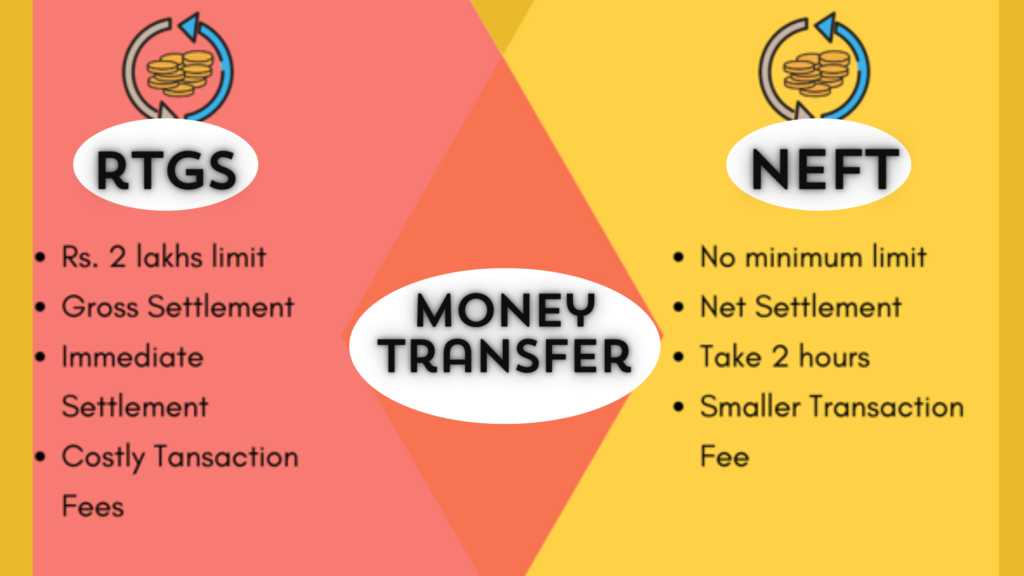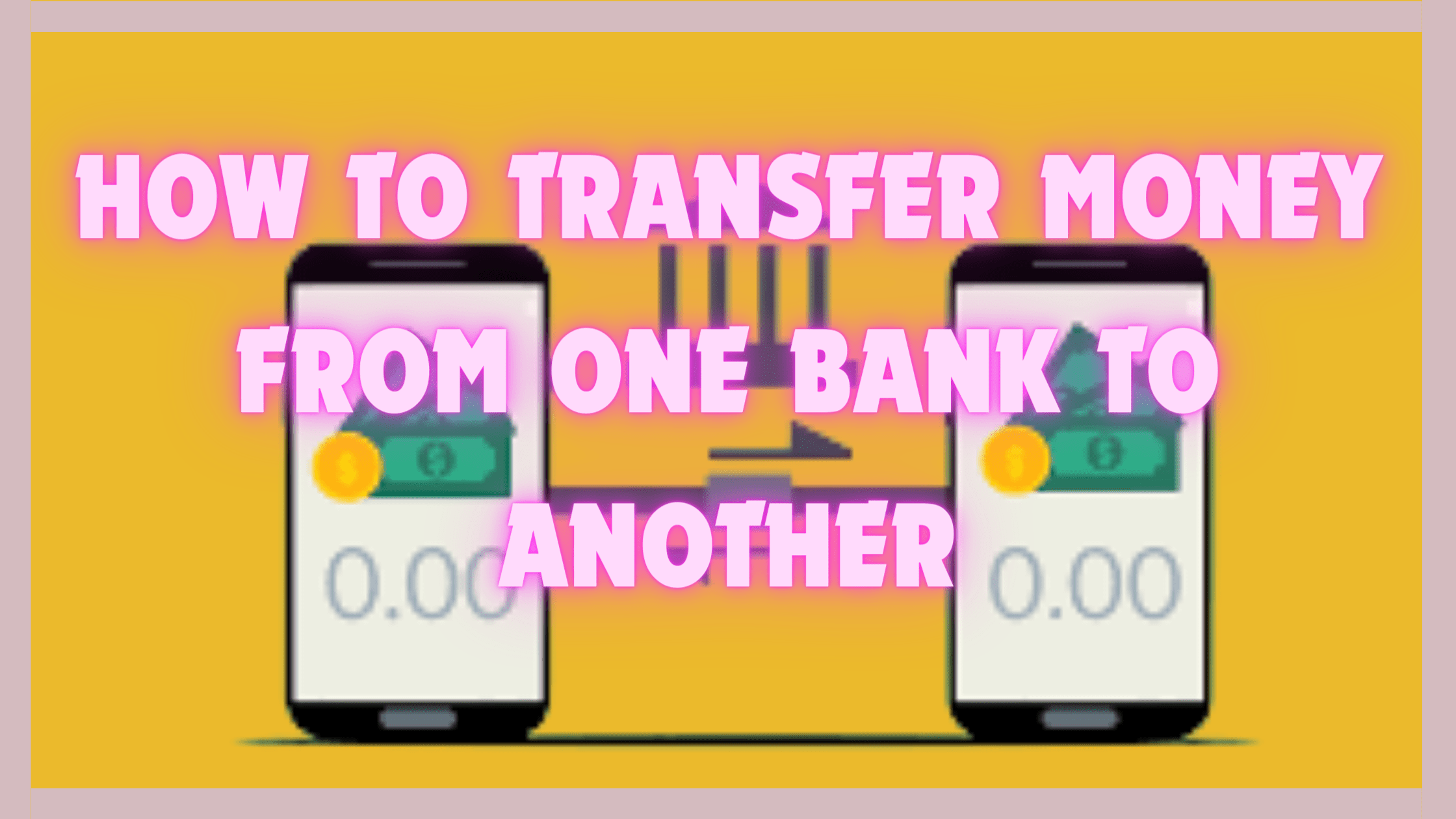How to transfer money from one bank to another?
Here are a few of the most popular techniques to transfer money from one bank to another:
1. National Electronic Fund Transfer (NEFT): NEFT is a widely used and straightforward method of transferring funds between bank accounts. Two crucial pieces of information are required to complete a NEFT transaction: the destination account’s IFSC code and the recipient’s account number. The total amount of money that may be sent using NEFT is unlimited. Individual banks, however, could impose a cap. The steps to complete a NEFT transfer are as follows:
o Select “Transfer to another bank” (NEFT) under the Fund Transfer menu.
Choose the recipient account and provide the necessary information.
I agree with the requirements.
Verify the information again and finish the procedure.
2. Real Time Gross Settlement (RTGS): Although RTGS credits to the destination account and has a different minimum payment than NEFT, the two systems are equivalent. If you would want to send more than 2 lakhs, you can use this. There is no cap on the total amount. RTGS is used for real-time money transactions. The money must be credited to the recipient’s bank account within thirty minutes of the transfer. The following are the stages involved in finishing an RTGS transfer:
o From the Fund Transfer option, choose “Transfer to another bank” (RTGS).
Select the recipient account and provide the required data.
o Accept the specifications.
o Confirm the details once again and complete the process.
3. Immediate Payment Service (IMPS): IMPS is a 24/7 instantaneous fund transfer service. IMPS is essentially the same as NEFT+RTGS. To prevent fraud concerns, there is a very modest ceiling on the transaction limit. To initiate an IMPS transfer, all you need to know is the mobile number and IMPS ID (MMID) of the recipient account holder. The steps to complete an IMPS transfer are as follows:
o Logging into Net Banking or Mobile Banking using your Customer ID and Password.
o Select the “Other Bank Account” button under Funds Transfer.
o Choose the beneficiary account, IMPS transfer method, and debit or credit account.
o After entering the desired transfer amount, click Submit.
o Press the button for confirmation.
o Verify all the details again, then accept the transaction by using the one-time password (OTP) that was sent to your registered cellphone number.
o Finally, click the submit button to confirm.
Check this out also Blink of an Eye: How Insurance Makes Eyelid Surgery Images Affordable and Accessible(2023)
Table of Contents
What is the difference between NEFT and RTGS?

In India, there are two widely used methods for transferring money between bank accounts: Real Time Gross Settlement (RTGS) and National Electronic Fund Transfer (NEFT). The following are the variations between the two:
1. Transaction Limit: The minimum transaction amount for RTGS is Rs. 2 lakhs, whereas there is no minimum amount for NEFT.(cleartax.in)
2. Transaction Speed: Real-time RTGS transactions are completed instantly, whereas half-hourly batches of NEFT transactions are handled.(dbs.com)
3. Service Availability: RTGS is only accessible during business hours, but NEFT is available around the clock.
4. Transaction Fees: Bank-to-bank differences exist in the transaction fees for RTGS and NEFT.
Can I use RTGS to transfer money abroad?
No, Real Time Gross Settlement (RTGS) is limited to domestic financial transfers inside India; it is not a worldwide fund transfer system. To transfer money overseas, you can, however, use the Foreign Outward Remittance service offered by institutions like HDFC Bank. With this service, you may send money anywhere in the world from the convenience of your home or place of business. These days, sending money abroad with RTGS/NEFT transfer is as simple as that.
Remittances can be sent at reasonable rates and fees to any country in the globe (save from those on the OFAC-sanctioned nations list). All you have to do is choose Funds Transfer, enter the amount to be transferred, accept the terms and conditions, and double-check the information after adding a beneficiary. Please be aware that an SMS containing a one-time password (OTP) sent to your registered mobile number is required to validate the beneficiary addition confirmation. Following a successful verification process, the beneficiary will be added and given a 30-minute cooling-off time.
How long does it take to transfer money abroad using HDFC Bank’s foreign outward remittance service?

The length of time it takes to send money overseas with HDFC Bank’s Foreign Outward Remittance service varies depending on several variables, including the destination nation, the method of transfer, and how long it takes the beneficiary bank to credit the money to the recipient’s account. On the other hand, the remittance process is quick and simple, with no lines, no checks, no paperwork or letters, and no hassles, according to the HDFC Bank website. With low rates and fees, you may send remittances to any country in the globe (except those on the OFAC-sanctioned nations list).
You may do the easy process from the convenience of your home or place of business. To initiate a fund transfer, just add a beneficiary, choose the desired amount to be sent, agree to the terms and conditions, and verify the information. Please be aware that a Time Password (OTP) sent to your registered mobile number via SMS is required to validate the confirmation of beneficiary inclusion. The beneficiary will be added after a successful authentication attempt, with a 30-minute cooling-off time.
What is the maximum amount I can transfer using HDFC Bank’s foreign outward remittance service?
The destination nation, the method of transfer, and the reason for the transaction all affect the maximum amount you may send using HDFC Bank’s foreign outward remittance service. On the other hand, the HDFC Bank website claims that there are no forms, letters, waits, checks, or other inconveniences with the remittance service and that it is quick and simple. Remittances can be sent at reasonable rates and fees to any country in the globe (save from those on the OFAC-sanctioned nations list).
You may finish the easy process in the convenience of your own home or place of business. All you have to do is choose Funds Transfer, enter the amount to be transferred, accept the terms and conditions, and double-check the information after adding a beneficiary. Please be aware that an SMS containing a one-time password (OTP) sent to your registered mobile number is required to validate the beneficiary addition confirmation. Following a successful verification process, the beneficiary will be added and given a 30-minute cooling-off time.
What is the cooling period for adding a beneficiary?
You are not able to start a fund transfer to a newly added beneficiary during the cooling-off period. An extra 30-minute cooling-off period following beneficiary addition is a notion that HDFC Bank has developed. To provide the client time to verify the payee if they were illegally or mistakenly registered, HDFC Bank sends SMS and email alerts of the beneficiary addition during this period. You can send money to the payee following the cooling-off period.
How do I know if my beneficiary has received the money?
The beneficiary bank is required to notify the beneficiary of the monies received after crediting the beneficiary’s account. The beneficiary’s Account Statement or Pass Book must bear the remitter’s name.
I hope this helps.

